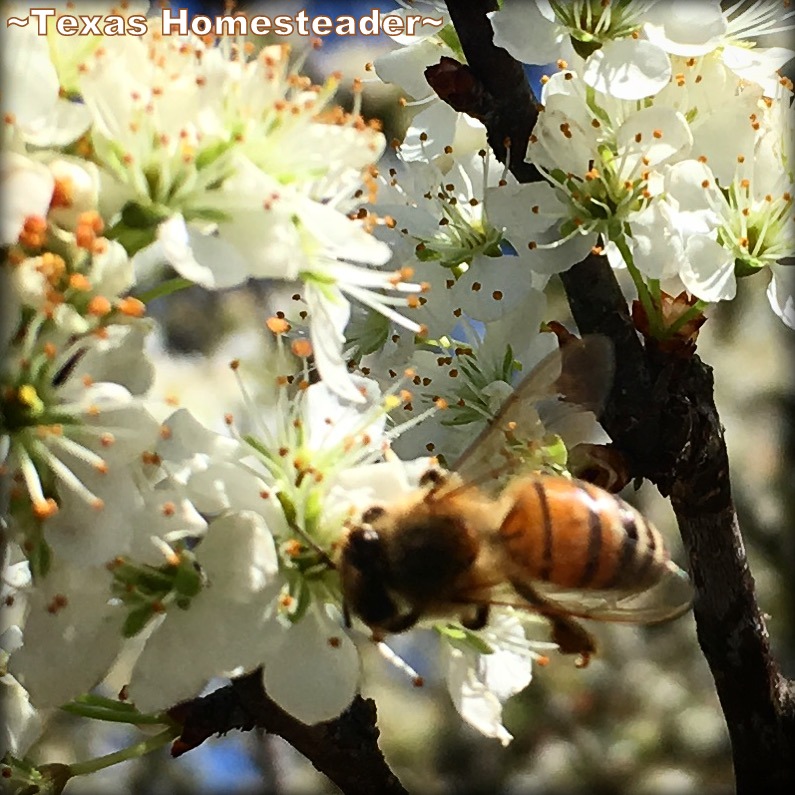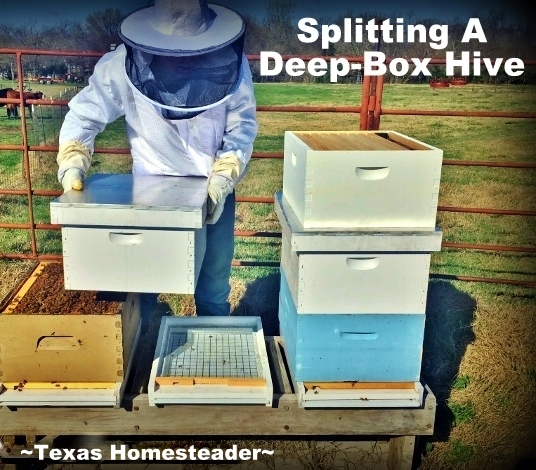by Texas Homesteader ~
For every beekeeper sooner or later there comes a time when you’ll need to perform a split. That’s when you split one hive into two. This doubles your hives and also gives the bees more room to build. There are several ways to do that, today I’m talking about a walk-away split.
It’s recommended that each apiary have a minimum of 2 hives. That way you can compare the hives to see if one is faltering.
There are many ways you can obtain your first set of bees:
Packaged Bees. A package of bees is usually 3 pounds of bees and a queen. You transfer them to your own hive box.
Nuc. You can buy a Nuc which is about 5 filled frames and a queen with a small amount of bees in a small box. You just transfer the filled frames to your own hive box.
Established Hive. Or you can buy established hives – Queen, bees, frames, hive box & all!
Inspecting Beehives Post Winter
But now that they’ve come through the winter, early spring is the time to check inside the hives to asses the health of the colonies.
Now that spring is coming things are really starting to green up here and flowers are beginning to bloom. I’m always excited to see the wild plum trees break out into bloom in our pastures. So are the bees!
Of course with the blooms and warm weather enticing them, the bees are becoming more active. Some of the workers are already coming back to the hive with their pollen pockets full.
They’re ramping up for a brand new year of honey production. So RancherMan & I wondered if the time was right to make a hive split.
What Is A Beehive Split?
A hive split is where you take a vibrant, healthy hive and split it in half, essentially giving you two hives where there was once just one. As with anything in beekeeping, there are many ways to accomplish a split.
Frame-Swap Split, Into an empty box & from a healthy hive transfer 2 frames of honey, 2 frames of brood and a frame of eggs, leaving the other 5 frames empty for expansion.
The frames pulled from the existing hive will be replaced with empty frames – also for expansion.
Some beekeepers add a queen to the split while others let the new hive re-queen itself. Bees are remarkable creatures. If there’s no queen in a hive the bees will take a brand new egg and feed it royal jelly until it hatches into the new queen.
Walk-Away Split. From a double-deep hive place the top hive box on a new bottom board. Then place a new empty hive box with empty frames on top of each hive. Replace the telescoping lid.
Our Walk-Away Split For Our Stronger Hive
We placed a new screened bottom board next to the strong hive. Since it’s still winter we added the insert to the screen to help keep the hive warm.
Then we removed the top full deep hive box from the existing hive and placed it on the new bottom board.
Finally we added a new deep hive box with empty frames to the top of both the new hive as well as the existing brown hive boxes.
Now both the new as well as the existing hive each contain a bottom deep box of full frames and bees topped with a new deep box with empty frames for them to expand to.
All that’s left to do is top both hives with a telescoping lid, strap ’em down in case of high winds and walk away.
Doubling Our Beehive Numbers
How exciting! Where there was once one hive with 2 full deep boxes, we now have two hives each containing a full box of brood, bees and honey! Both hives are topped with a deep hive box with empty frames for them to expand to. They’ll draw comb on those empty frames and just keep growing!
Whichever hive still contained the queen will simply carry on with business as usual. But the hive that does not now have a queen will simply grow a new one by feeding a new egg royal jelly until it hatches a new queen. Then they will carry on with business as usual also.
Leave ‘Em Alone For 2 Weeks
Although we still go to the bee enclosure and watch the comings & goings of the bees every day, we won’t break into the hives for a couple of weeks. Since it takes 21 days to requeen, there won’t be much to see until then anyway. And we want all the hives to get comfy with the changes before we disturb them.
If all goes well we’ll also be splitting our other existing hive soon (the blue one).
RancherMan’s in the process of building a second elevated beehive stand. He can build this type in only about 5 minutes using cinderblocks and landscape timbers.
That will give him enough room to hold that split as well as other hives we might add in the future. How exciting!
~TxH~
BEEKEEPING SERIES:
- Preparing For the Hives
- Obtaining Your Bees
- Inspecting Your Hives
- Feeding Bees With A Frame-Feeder
- Easy Homemade Candyboard For Winter Feeding
- Knowing When To Expand The Hive
- Performing A Walk-Away Split
- Performing A Frame-Swap Split
- 5-Minute Beehive Stand
- Adding A Honey Super To Your Hive
- Catching A Bee Swarm (With Video)
- Requeening A Beehive – Things We Didn’t Know
- Make FOUR 5-Frame Nuc Boxes From 1 Sheet of Plywood!
- Varroa Mite Treatment For Your Apiary
- Preparing Your Hive For Honey Harvest
- Proper Honey Bottling Tips
- Purifying Harvested Beeswax
- Simple Homemade Beeswax Lip Balm
- Homemade Beeswax Jar Candles
- Beeswax Wraps – A Natural Solution To Plastic Wrap
…And MUCH More!
See All Our Beekeeping Posts
C’mon by & sit a spell! Come hang out at our Facebook Page . It’s like sitting in a front porch rocker with a glass of cold iced tea. There are lots of good folks sharing! And you can also follow along on Pinterest, Twitter or Instagram
If you’d like to receive an email when a new blog post goes live,
subscribe to our Blog!






Love this post! I’ve often wondered about beekeeping and have a desire to do it when we retire and have property to place hives. Thanks so much for sharing this post at the Over the Moon Link Party. You’re my pick for Featured Blogger this week so come back and grab your Featured Blogger badge and share your latest posts with us.
I know of several friends that have bee hives. I can’t do that since I am extremely allergic to bees of all types and carry an epipen at all times.
Thanks for sharing at Over The Moon Party,
Bev
I’m not allergic, but I’ve always been so afraid of bees. Now that I’m more aware of how they live & work, I realize my fears were completely unfounded. Love these girls! ~TxH~
Hi, I am taking beekeeping classes this year, and was dismayed to learn that I had to order my bees and hives after only two classes! I was hoping to have more time to decide if beekeeping and I can mesh before having to order. I think I may finish out the course and get bees next year, after I am all educated about the subject. That way I have more time to gather equipment and set up my area, instead of half guessing at everything last minute.
Luckily one of my neighbors a mile or two up the road started keeping bees last year so hopefully my garden is better pollinated. Last summer was the first time I’d seen a honeybee on my property in three or four years!
Reading your posts on keeping bees keeps me inspired that I can do this! Good luck with your beekeeping endeavors, I’ll be reading!
I think you made a wise choice Amanda. RancherMan & I went to classes and learned as much as we possibly could through research for about a year before we got our first bees. It’s true that there’s no one way to raise bees, it must be flexible based on your operation and your location. That makes it difficult to have a ‘this is how you do it’ manual to just get started. Read all you can, join your local beekeepers association and network with those in your area and you’ll be way ahead of the game when you start raising your own bees! ~TxH~
I have found this bee topic very interesting to foiiow. We have not had many bees in the last few years.
A neighbor that had raised them passed away and someone took the hives he had. A new neighbor about 1/2 a mile away has brought several hives in, will they come that far to help pollinate our garden.
You make it look so easy, but I know it is not. So I’m going to pass on getting our own hives.
I’m hearing bees will forage in a 3-mile radius from their hive, so you should get some help Tonia. Fingers crossed for you! ~TxH~
I love bees in my gardens, but I’ll leave the beekeeping itself for the neighbour 5 miles away whose livelihood is centered around them. Deep underlying fear of insects? Check.
LOL – I had to overcome my fear of bees too. Thankfully I find that my fears have been unfounded. Now I regularly accompany RancherMan when he inspect the hives. They’re fascinating creatures and, you know, HONEY! LOL ~TxH~